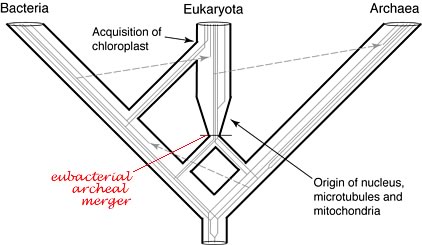|
Once the unnecessary
genes
were deleted, a new strategy emerged to "streamline" the
mitochondrial
genome -- the
transfer of mitochondrial genes to the nucleus.
This involves a complex
balancing
act. The more genes transferred out of the mitochondria, the faster
the
mitochondria can replicate.
There are cells with
essentially
no mitochondrial DNA -- they are known as rho0 cells. They have
small
"petite" mitochondria that do not support respiration, so
these
cells obtain all of their energy from glycolysis. In
most organisms, the rho0 phenotype would be lethal.
When a mitochondrial gene
essential
for respiration (or some other essential mitochondrial function) is
transferred
to the nucleus, it must be modified so that its gene product can be
reimported
back to the mitochondria.
This trick that can be
done,
and many originally mitochondria/bacterial genes now reside in the
nucleus.
In fact, in some organisms the mitochondria have retained the DNA
for
only five genes! (out of the thousands they started with).
Moving genes
and
resetting Muller's ratchet.
Moving genes to the
nucleus
has another advantage associated with sexual reproduction. Mutations
accumulate
in mitochondrial DNA genes. Through a process known as Muller's
ratchet, more and more mutations will accumulate -- leading
to
a decrease in the overall fitness of the mitochondria (with respect
to
its metabolic functions).
A new organism obtains
its
mitochondria from its mother. There no way to remove mitochondrial
mutations
except to eliminate the organism that carries them (here is a link
to human diseases related to defective mitochondria).
If mitochondrial genes
are
transferred to the nucleus, however, then the process of meiotic
recombination
can sort alleles away from one another. Those gametes/organisms that
contain
deleterious mutations are eliminated, while those that contain
neutral
or beneficial alleles survive.
Thus sex acts to reset
the
mutational load of the species. This appears to be one of the major
reason
that sexual reproduction evolved and has become the predominant mode
of
reproduction among higher organisms.
An obvious question then
is
why haven't all mitochondrial genes moved to the nucleus? follow
this
link
and the "related articles"
link
on pubmed.
|
